1.Arithmetic Progression Basics
The Concept Of Arithmetic Progression
Any given series of numbers may exhibit some special properties. A sequence of numbers in arithmetic progression is one of these special series.
Let us look at the following example.
Example 1: Check whether the following sequences form an A.P. or not.
(i)
(ii)
(iii)
(iv) A list of prime numbers greater than 2
(v) A list of the squares of natural numbers

(i) The given sequence is
Difference between the second and the first term


Difference between the third and the second term


Difference between the fourth and the third term


Since the difference between any two consecutive terms is a constant, the sequence is an arithmetic progression.
(ii) The given sequence is 
Difference between the second and the first term
Difference between the third and the second term
Difference between the fourth and the third term
Since the difference between any two consecutive terms is a constant, the sequence is an arithmetic progression.
(iii) The given sequence is 
This sequence can be rewritten as
Difference between the second and the first term
Difference between the third and the second term
Difference between the fourth and the third term
Since the difference between the consecutive terms is not a constant, the sequence is not an arithmetic progression.
(iv) The list of the prime numbers greater than 2 is: 3, 5, 7, 11 …
Difference between the second and the first term = 5 – 3 = 2
Difference between the third and the second term = 7 – 5 = 2
Difference between the fourth and the third term = 11 – 7 = 4
Since the difference between the consecutive terms is not a constant, the sequence is not an arithmetic progression.
(v) The list of the squares of natural numbers is: 12, 22, 32, 42 …
= 1, 4, 9, 16 …
Difference between the second and the first term = 4 – 1 = 3
Difference between the third and the second term = 9 – 4 = 5
Difference between the fourth and the third term = 16 – 9 = 7
Since the difference between the consecutive terms is not a constant, the sequence is not an arithmetic progression.
The Terminologies Related To Arithmetic Progressions
An arithmetic progression (A.P.) is a sequence in which the difference between any two consecutive terms is constant.
Now there are many common terms associated with an arithmetic progression, which one has to understand to solve any A.P. related problem.
Let us solve some more examples to understand this concept better.
Example 1: Find the common difference of the A.P.
Also, state whether it is finite or infinite and write down its first term.
Solution:
The given A.P. is
a1 = 
a2 = 
a3 = 
a4 =![]()

∴Common difference of the A.P. = 
First term of the A.P. =
The given A.P. is infinite because its last term cannot be calculated.
Example 2: State whether the following statements are true or false.
(i) The sequence  forms an A.P. with the first term as
forms an A.P. with the first term as and the common difference as
and the common difference as  .
.
(ii) The common difference of the A.P.  is .
is .
(iii) The nth term of an A.P. is given by 3n – 4. Its common difference is 4.
Solution:
(i) The given sequence is
Difference between the first and the second term
Difference between the second and the third term
Difference between the third and the fourth term
Since the difference between the consecutive terms of the sequence is constant, the given sequence is an A.P. with the first term as and the common difference as
and the common difference as  .
.
Thus, the statement is false.
(ii) The given A.P. is
Common difference of the A.P. =
Thus, the statement is true.
(iii) It is given that the nth term of the A.P. is given by 3n – 4.
Thus, first term of the A.P. = a = 3 × 1 – 4 = 3 – 4 = –1
Second term of the A.P. = a2 = 3 × 2 – 4 = 6 – 4 = 2
Third term of the A.P. = a3 = 3 × 3 – 4 = 9 – 4 = 5
Fourth term of the A.P. = a4 = 3 × 4 – 4 = 12 – 4 = 8
Thus, common difference of the A.P. = 8 – 5 = 5 – 2 = 2 – (–1) = 3
Thus, the statement is false.
Missing Terms In Arithmetic Progressions
An arithmetic progression (A.P.) is a sequence in which the difference between any two consecutive terms is constant.
Now if we are given an A.P. 3, 6, 9, ?, 15 and asked to find the missing term, then how will we go about it?
Let us now solve some problems based on this concept.
Example 1: Find the missing terms in the following arithmetic progressions.
(i) 
(ii) 
Solution:
(i) In the given A.P.,
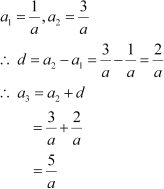
Thus, missing term, a3
(ii) In the given A.P.,
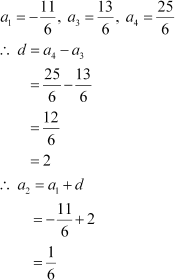
Thus, missing term, a2 =
Example 2: Find the first two terms of an A.P. in which the third term is 10 and the common difference is 7.
Solution:
Here, d = 7 and a3 = 10
Hence, the value of a2 can be found by subtracting 7 from a3.
∴ a2 = 10 − 7 = 3
Similarly, the value of a1 can be found by subtracting 7 from a2.
∴ a1 = 3 − 7 = −4
Thus, the first two terms of the A.P. are –4 and 3.
2.Nth Term of Arithmetic Progression
Nth Term Of An Arithmetic Progression
We know what an arithmetic progression (A.P.) is. Also, we have learnt that there is a common difference between any two consecutive terms of an A.P..
Now, can we find the required term of a given A.P. with this information? Let us consider the A.P. 3, 7, 11, 15,...
Here, first term (a) = 3 and common difference (d) = 4
Now, if we want to find the 5th term of this A.P., then we will simply add the common difference to 4th term. Thus, 5th term of this A.P. will be 15 + 4 = 19.
What would we do if we are asked to find the 20th term or 100th term or nth term? Obviously, the process of adding common difference will be very time consuming.
For such problems, we must have a short cut or a formula to find the general term of an A.P. Let us derive the same.
Consider the A.P. a, a + d, a + 2d, a + 3d, ...
For this A.P., we have
a1 = a
a2 – a1 = d a3 – a2 = d
. . .
. . .
. . .
an – 1 – an – 2 = d
an – an – 1 = d
Adding all these equations, we get
a1 + (a2 – a1) + (a3 – a2) +...+ (an – 1 – an – 2) + (an – an – 1) = a + {d + d +... + d (n – 1 times)}
⇒(a1 – a1) + (a2 – a2) + (a3 – a3) +...+ (an – 1 – an – 1) + an = a + (n – 1)d
⇒an = a + (n – 1)d
Hence, the general term or nth term i.e., an of an A.P. whose first term is a and common difference is d can be found by the following formula:
an = a + (n – 1)d
Sometimes, we need to find three, four or five consecutive terms of an A.P. then it is convenient to take them as follows:
- Three consecutive terms can be taken as a – d, a, a + d
- Four consecutive terms can be taken as a – 3d, a – d, a + d, a + 3d. Here, common difference is 2d.
- Five consecutive terms can be taken as a – 2d, a – d, a, a + d, a + 2d
Result:
In an A.P., common difference,  , where Tp and Tq are pth and qth term respectively.
, where Tp and Tq are pth and qth term respectively.
In particular,  .
.
Proof:
Tp = a + (p – 1)d, Tq = a + (q – 1)d
⇒Tp – Tq = a + (p – 1)d – {a + (q – 1)d} = (p – q)d

In particular, take T1 = a.
Then, 
Now, let us solve some examples to understand the concept better.
Example 1: Find the 20th term of the following arithmetic progression. 0.4, 1.5, 2.6, 3.7, 4.8 …
Solution:
Here, a = 0.4 and d = 1.5 – 0.4 = 1.1
Thus, the 20th term is given by,
a20 = a + (20 – 1) d
= 0.4 + (20 – 1) 1.1
= 0.4 + 19 × 1.1
= 0.4 + 20.9
= 21.3
Thus, the 20th term of the given A.P. is 21.3.
Example 2: If the 7th term of an A.P. is – 21 and 15th term is – 53, then find the first term and common difference.
Solution:
Let the first term and common difference of the A.P. be a and d respectively.
It is given that a7 = –21 and a15 = –53
Using the formula for nth term, we obtain
a7 = a + (7 – 1) d
– 21 = a + 6d … (1)
and, a15 = a + (15 – 1) d
– 53 = a + 14d … (2)
Subtracting equation (1) from (2), we obtain
–32 = 8d
⇒ d = –4
Substituting the value of d in equation (1), we obtain
–21 = a + 6 (–4)
–21 = a – 24
⇒ a = 3
Thus, the first term is 3 and the common difference is –4.
Example 3: Is 102 a term of the A.P., 5, 11, 17, 23 …?
Solution:
Let 102 be the nth term of the given sequence.
∴ an = 102
Using the formula for nth term, we obtain
an= a + (n – 1) d
∴ 102 = a + (n – 1) d
For the given A.P., a = 5 and d = 11 – 5 = 6
∴ 102 = 5 + (n – 1) 6
102 – 5 = (n – 1) 6
97 = (n – 1) 6



However, n should be a positive integer. Therefore, 102 is not a term of the given A.P.
Example 4: Find the number of three-digit numbers that are divisible by 5.
Solution:
The first three-digit number which is divisible by 5 is 100, second is 105, third is 110, and so on. The last three-digit number which is divisible by 5 is 995.
Thus, we obtain the following A.P. 100, 105 … 995
Here, we have to find the number of terms, n.
∴Last term of A.P. = 995
The number of terms in the A.P. is n, so the last term is the nth term.
a + (n – 1)d = 995
Here, a = 100 and d = 5
100 + (n – 1)5 = 995
(n – 1)5 = 995 – 100
5n – 5 = 895
5n = 895 + 5
5n = 900

n = 180
Thus, there are 180 three-digit numbers, which are divisible by 5.
Example 5: The fare of a bus is Rs 10 for the first kilometre and Rs 5 for each additional kilometre. Find the fair after 12 kilometres.
Solution:
The fare after each kilometre forms an A.P. as follows.
Fare after one kilometre = Rs 10
Fare after two kilometres = 10 + 5 = Rs 15
Fare after three kilometres = 15 + 5 = Rs 20
Now the arithmetic progression is 10, 15, 20 …
Here, first term, a = 10 and common difference, d = 5
Now the fare after 12 kilometres is the 12th term of the A.P.
∴ a12 = a + (12 – 1) d
a12 = 10 + 11 × 5
= 10 + 55
= 65
Thus, the fare after 12 kilometres is Rs 65.
Example 6: Mohit borrowed a sum of money at a simple interest rate of 2% per annum. He has to pay an amount of Rs 1120 after 6 years. How much money did he borrow?
Solution:
Let the amount of money Mohit borrowed be Rs x. We know that the amount after T years is

Where, P and R denotes the principal and rate respectively
The amount after every year forms an A.P.
Amount after first year

Amount after second year

Thus, the A.P. is as follows.

Here, the first term is  and common difference is
and common difference is  .
.
Now, it is given that the amount after 6 years is Rs 1120 i.e., 6th term of the A.P. is 1120. Now using the formula, an = a + (n – 1)d, we obtain

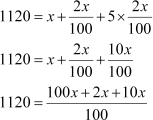
1120 × 100 = 112x
x = 1000
Thus, Mohit borrowed Rs 1000.
Example 7: Find four consecutive terms of an A.P. such that the difference of the middle terms is 8 and the product of the extreme terms is 217.
Solution:
Let four consecutive terms of required A.P. be a – 3d, a – d, a + d, a + 3d.
According to the question, we have
a + d – (a – d) = 8
⇒ a + d – a + d = 8
⇒ 2d = 8
⇒ d = 4 Also,
(a – 3d)(a + 3d) = 217
⇒ a2 – (3d)2 = 217
⇒ a2 – 9d2 = 217
⇒ a2 – 9(42) = 217
⇒ a2 – 144 = 217
⇒ a2 = 361
⇒ a = ±19
When d = 4 and a = 19, then four consecutive terms are:
19 – 3(4), (19 – 4), (19 + 4), 19 + 3(4)
i.e., 7, 15, 23, 31
When d = 4 and a = –19, then four consecutive terms are:
–19 – 3(4), (–19 – 4), (–19 + 4), –19 + 3(4)
i.e., –31, –23, –15, –7
Example 8: Find five consecutive terms of an A.P. such that the product of the extreme terms is –63 and product of second and fourth terms is –15.
Solution:
Let five consecutive terms of required A.P. be a – 2d, a – d, a ,a + d, a + 2d.
According to the question, we have
(a – 2d)(a + 2d) = –63
⇒ a2 – (2d)2 = –63
⇒ a2 – 4d2 = –63 ...(1)
Also,
(a – d)(a + d) = –15
⇒ a2 – d2 = –15 ...(2)
On subtracting (1) from (2), we get
3d2 = 48
⇒ d2 = 16
⇒ d = ±4
On substituting d2 = 16 in (2), we get
a2 – 16 = –15
⇒ a2 = 1
⇒ a = ±1
When a = 1 and d = 4, A.P. will be –7, –3, 1, 5, 9
When a = 1 and d = –4, A.P. will be 9, 5, 1, –3, –7
When a = –1 and d = 4, A.P. will be –9, –5, –1, 3, 7
When a = –1 and d = –4, A.P. will be 7, 3, –1, –5, –9
Example 9: If the 25th and 35th terms of an arithmetic progression are 121 and 171 respectively, then find the common difference of the A.P.
Answer:
T25 = 121, T35 = 171
It is known that common difference,  .
.

Example 10: In an A.P, show that  .
.
Answer:


Therefore, 
2.Nth Term of Arithmetic Progression
- Books Name
- Sample paper Term II Maths
- Publication
- SonikaAnandAcademy
- Course
- CBSE Class 10
- Subject
- Mathmatics
Nth term of AP
a+(n-1) d
Where a. is first term d is common difference and n is number of terms
Que find 5th term for series
2,4,6,8.......
a= 2. d=4-2=2. n = 5
T(5) = 2+(5-1)2
= 2+4×2
= 2+8=10
3.Sum of N Terms of Arithmetic Progression
Sum of n Terms of an Arithmetic Progression
We know what an arithmetic progression (A.P.) is. Sometimes, we may come across the situations when we have to find the sum of all terms involved in a series and if the series is an AP, then there is a formula which can make the process very simple.
Let us consider a similar situation.
Harry saved Rs 2000 from his salary in the first month. He increases his savings by Rs 50 every month.
Can we calculate his total savings for the first four months?
Let us try to find it.
To find the total savings for the first 4 months, we have to take the sum of the savings for the first four months.
It is given that, savings of Harry for the first month = Rs 2000
Every month, he increases his savings by Rs 50.
Thus, savings for second month = Rs (2000 + 50) = Rs 2050
Similarly, savings for the third month = Rs (2050 + 50) = Rs 2100 nd,
savings for the fourth month = Rs (2100 + 50) = Rs 2150
Thus, the total savings of Harry for the first four months = Rs (2000 + 2050 + 2100 + 2150)
= Rs 8300
Now, can we calculate the total savings of Harry for 2 years?
Yes, we can find it as above but it is a very lengthy as well as time consuming process as we have to find the savings for 24 months.
We can also find the total savings of Harry for first two years using a formula. Now, let us see how we can find it.
The savings of Harry for each month forms an A.P., which is as follows. 2000, 2050, 2100, 2150 ….
The sum of savings of Harry = Rs (2000 + 2050 + 2100 + 2150 ….)
Here, we can observe that the total savings of Harry for the first month is the first term of the A.P., i.e. Rs 2000. The total savings for the first two months is the sum of first two terms of the A.P., i.e. Rs (2000 + 2050). In the same way, the total savings of Harry for first 2 years, i.e. 24 months, is the sum of first 24 terms of the A.P. We can find it by using the formula for finding the sum of n terms of an A.P.
Now, let us find the sum of first 24 terms of the above discussed A.P. which is as follows: 2000, 2050, 2100, 2150 ….
Here, first term, a = 2000
Common difference, d = 2050 − 2000 = 50
The sum of first 24 terms of the A.P. is
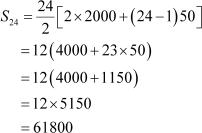
Therefore, the total savings of Harry for the first two years is Rs 61800.
This formula is used when we are given the first term and the common difference of the arithmetic progression.
We can also find the sum of n terms of an A.P., if we know the first and the last term.
The sum of n terms of an A.P. whose first term is a and last term is l is given by the formula:

For example, consider an A.P. whose first term is 2 and 30th term is 263. Then, what will be the sum of 30 terms?
Here, a = 2, l = 263 and n = 30
Therefore, sum of 30 terms

= 15 × 265
= 3975
Thus, the sum of 30 terms is 3975.
Result: The sum of the first n natural numbers is given by  .
.
Proof:
This can be proved by two methods.
1st method (Using concept of A.P.):
The first n natural numbers can be listed as 1, 2, 3, …, n.
Here, a = 1, d = 1.

2nd method (Without using concept of A.P.):
Sn = 1 + 2 + 3 + … + n … (1)
Sn = n + (n – 1) + (n – 2) + … + 3 + 2 + 1 … (2)
Adding (1) and (2):
2Sn = (n + 1) + (n + 1) + …… + (n + 1)
Here, there are n terms in the RHS.

Now, let us discuss some more examples based on sum of n terms of an A.P.
Example 1: Find the sum of first 25 terms of the following A.P. 2, 7, 12 …
Solution:
Here, a = 2 and d = 7 − 2 = 5.
Sum of the first 25 terms is given by
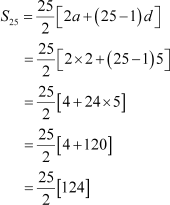
= 25 × 62
= 1550
Thus, the sum of first 25 terms of the given A.P. is 1550.
Example 2: Find the sum of first 8 terms of the A.P whosenthterm is given by 6n − 5.
Solution:
The nth term is given by
an = 6n − 5
On replacing n by 1, 2, 3 … respectively, we get the first, second, third … terms of the A.P.
∴ a1 = 6(1) − 5 = 1
a2 = 6(2) − 5 = 7
a3 = 6(3) − 5 = 13 … and so on.
The A.P. so obtained is as follows.
1, 7, 13 …
Here, the first term, a = 1
and the common difference d = a2 − a1 = 7 − 1 = 6
Using the formula, ,  the sum of first 8 terms is given by
the sum of first 8 terms is given by
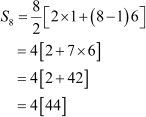
= 176
Thus, the sum of first 8 terms is 176.
Example 3: How many terms of the A.P. −28, −24, −20 … should be taken so that the sum will be zero?
Solution:
Let the sum of n terms be zero.
Here, a = − 28 and d = − 24 − (−28) = 4
Sum of n terms of an A.P. is given by

But, it is given that the sum of n terms of the given A.P. is zero.
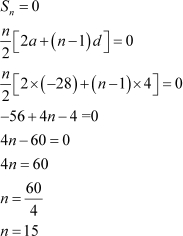
Thus, the sum of 15 terms of the A.P is zero.
Example 4: Sapna’s father planted 4 trees in his garden, when he was 22 years old. After that, every year he planted one more tree than the number of trees he planted in the previous year. How many trees will be there in his garden when he will become 40 years old?
Solution:
We can write the given information in the form of an A.P. as follows
Number of trees he planted in the first year = 4
Number of trees he planted in the second year = 4 + 1 = 5
Number of trees he planted in the third year = 5 + 1 = 6
And so on.
Now, the A.P. is 4, 5, 6 …
He planted trees from the age of 22 years to 40 years, i.e. for 19 years.
Thus, we have to find the sum of 19 terms of this A.P.
Here, a = 4, d = 1
And, n = 19
Using the formula, ,  the sum of 19 terms of this A.P. is given by
the sum of 19 terms of this A.P. is given by
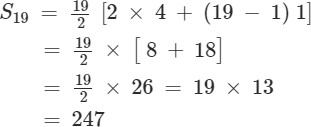
Thus, there will be 247 trees in his garden when he will become 40 years old.
Example 5: The  term of an A.P. is q and the
term of an A.P. is q and the  term of the A.P. is p. What is the sum of (p + q) terms of the A.P.?
term of the A.P. is p. What is the sum of (p + q) terms of the A.P.?
Solution:
Let the first term and the common difference of the A.P. be a and d respectively.
It is given that the  term is q.
term is q.
∴ ap = q
⇒ a + (p − 1) d = q … (1)
Similarly, the qth term is p, therefore we obtain
a + (q − 1) d = p … (2)
On subtracting equation (1) from (2), we obtain
p − q = (q − 1) d − (p − 1) d
p − q = d [q − 1 − p + 1]

By putting the value of d in equation (1), we obtain
q = a + (p − 1) (−1)
q = a + 1 − p
a = p + q − 1
But we know that the sum of n terms of an A.P. is

Thus, the sum of (p + q) terms is
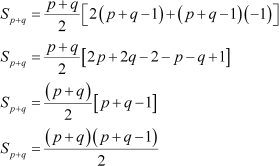
Thus, the sum of (p + q) terms is .
Example 6: Find the nth term of the A.P., the sum of whose n terms is n2 + 2n.
Solution:
Let Sn be the sum of n terms.
It is given that the sum of n terms of the A.P. is n2 + 2n.
∴ Sn = n2 + 2n … (1)
On replacing n by (n − 1) in the equation, we obtain

Let an be the nth term of the A.P. Therefore, we can write
Sn = Sn−1 + an
Thus, an = Sn − Sn−1
= n2 + 2n − [(n − 1)2 + 2(n − 1)]
= n2 + 2n − [n2 + 1 − 2n + 2n − 2]
= n2 + 2n − n2 + 1
= 2n + 1
Thus, the nth term of the A.P is (2n + 1).
Example 7: Find the sum of first 1000 natural numbers.
Solution:
The sum of first n natural number is given by  .
.

Hence, the sum of first 1000 natural numbers is 500500.
Example 8: If sum of the first n natural numbers is 5050, find the value of n.
Solution:
The sum of first n natural number is given by  . Now,
. Now,
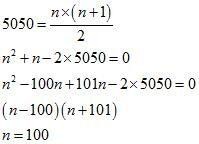
Hence, n = 100
Properties of Arithmetic Progressions and the Concept of Arithmetic Mean
Arithmetic progression is a sequence of numbers such that the difference between the consecutive terms is a constant. It exhibits some properties which are used in solving various problems.
Properties of an Arithmetic Progression
- If a constant is added to each term of an A.P., the resulting sequence will also be an A.P.
- If a constant is subtracted from each term of an A.P., the resulting sequence will also be an A.P.
- If a constant is multiplied to each term of an A.P., the resulting sequence will also be an A.P.
- If each term of an A.P. is divided by a non-zero constant, the resulting sequence is also an A.P.
Arithmetic Mean
If we are given two numbers a and b, then we can insert a number A between these two numbers so that the sequence a, A, b becomes an A.P. Such a number i.e., A is called an arithmetic mean (A.M.) of the numbers a and b.
If A is the A.M. of the numbers a and b, then A is given by A =  .
.
For example, the A.M. of the two numbers 18 and 16 is  .
.
For any two given numbers a and b, we can insert as many numbers between them as we want such that the resulting sequence becomes an A.P.
Example 1: Between −12 and 40, p numbers have been inserted in such a way that the resulting sequence is an A.P. Find the value of p if the ratio of the 4th and the (p −
3)th number is 1 : 6.
Solution:
Let A1, A2, … Ap be p numbers such that −12, A1, A2, … Ap, 40 is an A.P.
Here, a = −12, b = 40, n = p + 2
∴ 40 = −12 + (p + 2 − 1) (d)
⇒ 52 = (p + 1) d

A1 = a + d
A2 = a + 2d
A3 = a + 3d …
∴ A4 = a + 4d
Ap−3 = a + (p − 3) d
According to the given information,
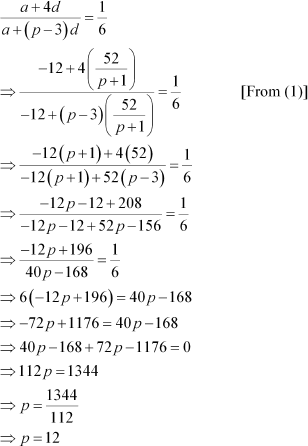
Thus, the value of p is 12.
Example 2: Between 10 and 30, m numbers are inserted such that the resulting sequence is an A.P. If the sum of all the terms of the A.P. is 140, then find the value of m.
Solution:
It is given that between 10 and 30, m numbers are inserted such that the resulting sequence is an A.P.
It is also given that the sum of all the terms in the A.P. is 140.
We know that the sum of n terms of an A.P. is given by
 , where a is the first term and l is the last term
, where a is the first term and l is the last term
Here, a = 10, l = 30
Therefore,
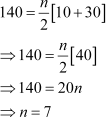
Thus, the total number of terms in the A.P. is 7.
Thus, the value of m is 7 − 2 = 5.
3.Sum of N Terms of Arithmetic Progression
- Books Name
- Sample paper Term II Maths
- Publication
- SonikaAnandAcademy
- Course
- CBSE Class 10
- Subject
- Mathmatics
Sum of series
S= n/2{2a+(n-1)d}
Find sum of series for
3,6,9,12....... Up to 20 terms
first term 3
common difference 6-3=3
number of terms n=20
S = 20/2 {2×3+(20-1)×3}
= 10 {6+19×3}
= 10 × {6+57}
= 630

 ACERISE INDIA
ACERISE INDIA
 SonikaAnandAcademy
SonikaAnandAcademy
